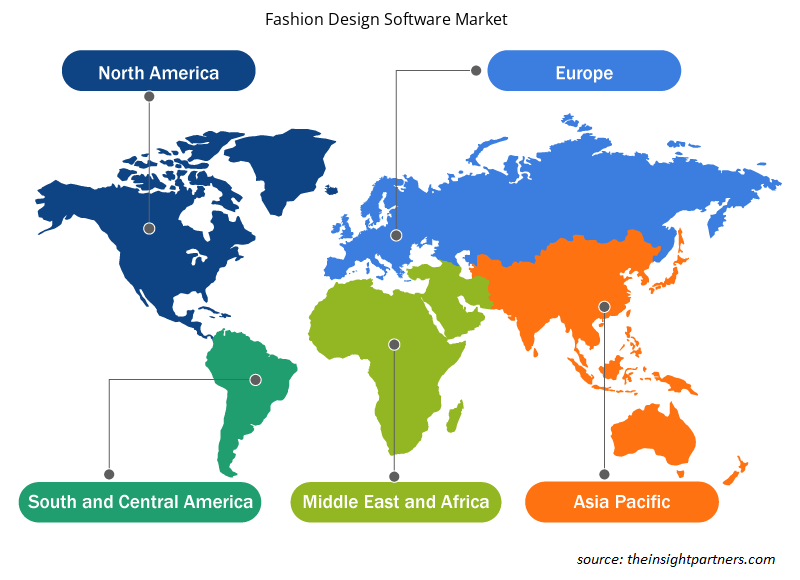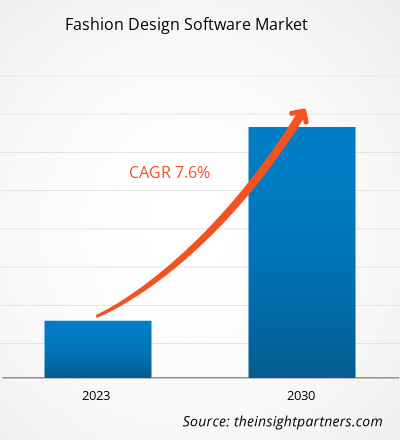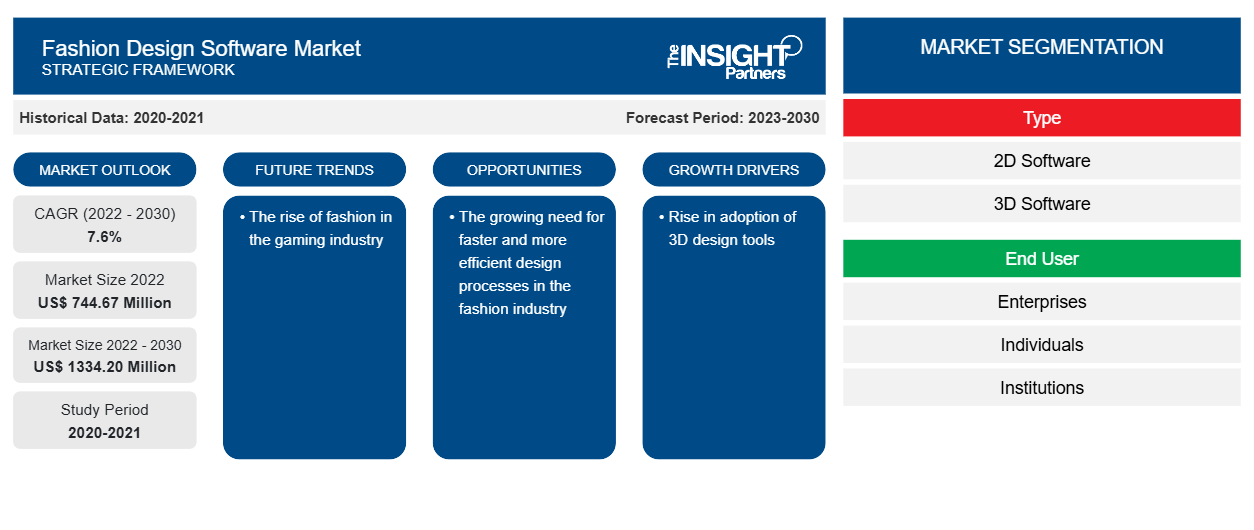패션 디자인 소프트웨어 시장 규모는 2022년 7억 4,467만 달러에서 2030년까지 1,334.20만 달러로 성장할 것으로 예상됩니다. 이 시장은 2022~2030년 동안 7.6%의 CAGR을 기록할 것으로 예상됩니다. A. 패션 산업에서 3D 디자인 도구 채택 증가와 더 빠르고 효율적인 디자인 프로세스에 대한 필요성이 커짐에 따라 시장의 주요 트렌드로 남을 가능성이 높습니다.
패션 디자인 소프트웨어 시장 분석
패션 디자인 소프트웨어 시장 의 주요 동인 중 하나는 주문형 맞춤형 제작의 증가하는 추세입니다. 패션에 대한 인식이 높아지고 개성에 대한 욕구가 커지면서 소비자는 자신의 성격과 가치를 반영하는 독특하고 개인화된 의류 품목을 찾고 있습니다. 패션 디자인 소프트웨어는 디자이너가 맞춤형 서비스를 제공할 수 있도록 지원하여 구매자가 자신의 특정 요구 사항과 선호도에 따라 구매를 미리 보고 맞춤화할 수 있도록 합니다. Amazon Fashion 및 Louoj와 같은 시장 참여자는 이미 가상 도구와 3D 디자인 맞춤형 소프트웨어를 출시하여 개인화된 패션 경험에 대한 수요를 충족했습니다. 주요 동인 중 하나는 패션 산업에서 3D 디자인 도구 채택이 증가하는 것입니다. 패션 디자이너는 Adobe Illustrator, Bluecherry, Browzwear, C-Design Fashion과 같은 고급 CAD 스케치 도구를 사용하여 디자인 프로세스를 크게 개선하고 있습니다. 이러한 도구를 사용하면 디자이너가 의류를 디지털 방식으로 만들고 시각화하여 실제 샘플링 및 프로토타입에 대한 의존도를 줄일 수 있습니다. 여러 디자인 변형을 탐색하고 다양한 소재와 패턴에 적용할 수 있는 기능은 디자인 프로세스를 간소화하고 보다 혁신적이고 독특한 디자인으로 이어집니다.
패션 디자인 소프트웨어 시장 개요
패션 디자인 기술의 광범위한 채택은 의류, 패션 및 럭셔리(AF&L) 산업이 제품을 디자인, 개발 및 마케팅하는 방식을 변화시키고 있습니다. 패션 디자인 소프트웨어는 패션 디자인 개발 프로세스를 간소화하여 시간과 비용을 줄이고 환경적 영향을 줄입니다. 전 세계적으로 디지털화가 증가함에 따라 패션 디자인 소프트웨어 솔루션 채택이 이루어지고 있습니다.
귀하의 요구 사항에 맞게 이 보고서를 사용자 정의하세요
이 보고서의 일부 또는 국가 수준 분석, Excel 데이터 팩을 포함하여 모든 보고서에 대한 사용자 정의를 무료로 받을 수 있으며 신생 기업 및 대학을 위한 훌륭한 혜택과 할인 혜택을 이용할 수 있습니다.
-
이 보고서의 주요 시장 동향을 알아보세요.이 무료 샘플에는 시장 동향부터 추정 및 예측까지 다양한 데이터 분석이 포함됩니다.
패션 디자인 소프트웨어 시장 동인 및 기회
패션산업 확장
패션 디자인 소프트웨어 시장 성장은 디자인 도구와 신기술의 사용 증가와 업계의 확장 노력에 의해 주도되고 있습니다. 2022년 11월, CLO Virtual Fashion은 뮌헨과 마드리드에 있는 기존 사무실에 파리로 확장했습니다. 이 단계를 통해 프랑스 패션 커뮤니티에서 패션 디자인 기술 채택이 촉진되었고 전 세계적으로 더 나은 지원과 서비스가 가능해졌습니다.
개발도상국에서 소프트웨어 솔루션 채택 증가
기업들은 기술적으로 진보된 솔루션을 채택하고 고객과 연결할 새로운 방법을 찾고 있습니다. 이를 위해 3D로 이동하고 있습니다. 3D는 많은 기술 발전의 핵심입니다. 3D 기술은 기하학적 데이터의 그래픽 표현에 도움이 됩니다. 다양한 앱의 등장으로 고객은 구매하기 전에 아바타로 옷을 입어볼 수도 있습니다. 이는 가상으로 무언가를 구매할 때의 의심을 해소하는 데 도움이 됩니다. 패션 디자인 소프트웨어는 또한 "주문형 패션"이라고 하는 맞춤형 제품을 만들 수 있게 했습니다. 인도와 같은 나라에서 패션은 다양한 의미와 목적을 가지고 있습니다. 전체적인 교육에 초점을 맞추면 윤리적이고 인식력이 뛰어나며 소프트웨어의 도움으로 다가올 시대에 발생할 새로운 문제와 이슈를 해결하기 위해 틀에서 벗어난 생각을 할 수 있는 학생과 디자이너가 탄생할 것으로 기대됩니다.
패션 디자인 소프트웨어 시장 보고서 세분화 분석
패션 디자인 소프트웨어 시장 분석에 기여한 주요 세그먼트는 유형과 최종 사용자입니다.
- 패션 디자인 소프트웨어 시장은 유형에 따라 2D 소프트웨어와 3D 소프트웨어로 나뉩니다. 3D 세그먼트는 가장 높은 CAGR로 성장할 것으로 예상됩니다.
- 최종 사용자별로 시장은 기업, 개인, 기관으로 세분화됩니다. 개인 세그먼트는 가장 높은 CAGR로 성장할 것으로 예상됩니다.
지리적 지역별 패션 디자인 소프트웨어 시장 점유율 분석
패션 디자인 소프트웨어 시장 보고서의 지리적 범위는 주로 북미, 아시아 태평양, 유럽, 중동 및 아프리카, 남중부 아메리카의 5개 지역으로 나뉩니다.
북미 지역은 상당한 시장 점유율을 차지했습니다. 이 지역에는 많은 성공적인 의류 디자인 및 제조 회사가 있습니다. 이 지역의 의류 사업은 신규 진입자를 쉽게 수용했으며 정부 정책과 관련하여 진입 장벽이 거의 없습니다. 예를 들어, 2022년 3월 7일 캐나다의 Nextech는 여러 3D 모델 AR 전자 상거래 계약을 체결했습니다. 증강 현실("AR") 경험 기술 및 서비스의 선도적 공급업체인 Nextecha는 Nextech에 새로운 산업을 포함하여 여러 산업에서 여러 3D 모델 AR 전자 상거래 계약을 체결했다고 발표하여 회사의 전자 상거래 3D 모델링 분야로의 영향력을 더욱 확대했습니다.
패션 디자인 소프트웨어 시장 지역 통찰력
Insight Partners의 분석가들은 예측 기간 동안 패션 디자인 소프트웨어 시장에 영향을 미치는 지역적 추세와 요인을 철저히 설명했습니다. 이 섹션에서는 북미, 유럽, 아시아 태평양, 중동 및 아프리카, 남미 및 중미의 패션 디자인 소프트웨어 시장 세그먼트와 지리에 대해서도 설명합니다.

- 패션 디자인 소프트웨어 시장을 위한 지역별 특정 데이터 얻기
패션 디자인 소프트웨어 시장 보고서 범위
| 보고서 속성 | 세부 |
|---|---|
| 2022년 시장 규모 | 7억 4,467만 달러 |
| 2030년까지 시장 규모 | 13억 3,420만 달러 |
| 글로벌 CAGR (2022-2030) | 7.6% |
| 역사적 데이터 | 2020-2021 |
| 예측 기간 | 2023-2030 |
| 다루는 세그먼트 |
유형별로
|
| 포함된 지역 및 국가 |
북아메리카
|
| 시장 선도 기업 및 주요 회사 프로필 |
|
패션 디자인 소프트웨어 시장 참여자 밀도: 비즈니스 역학에 미치는 영향 이해
패션 디자인 소프트웨어 시장 시장은 소비자 선호도의 변화, 기술 발전, 제품의 이점에 대한 인식 증가와 같은 요인으로 인해 최종 사용자 수요가 증가함에 따라 빠르게 성장하고 있습니다. 수요가 증가함에 따라 기업은 제품을 확장하고, 소비자의 요구를 충족하기 위해 혁신하고, 새로운 트렌드를 활용하여 시장 성장을 더욱 촉진하고 있습니다.
시장 참여자 밀도는 특정 시장이나 산업 내에서 운영되는 회사나 기업의 분포를 말합니다. 주어진 시장 공간에 얼마나 많은 경쟁자(시장 참여자)가 존재하는지 그 규모나 총 시장 가치에 비해 나타냅니다.
패션 디자인 소프트웨어 시장에서 운영되는 주요 회사는 다음과 같습니다.
- 어도비 주식회사
- 오토메트릭스 주식회사
- 브라우즈웨어 솔루션스 주식회사
- CLO 가상 패션 유한회사
- 렉트라 SA
- 하퍼 아링턴 출판사 LLC
면책 조항 : 위에 나열된 회사는 어떤 특별한 순서에 따라 순위가 매겨지지 않았습니다.

- 패션 디자인 소프트웨어 시장 주요 업체 개요를 알아보세요
패션 디자인 소프트웨어 시장 뉴스 및 최근 개발
패션 디자인 소프트웨어 시장은 1차 및 2차 연구 이후의 질적, 양적 데이터를 수집하여 평가합니다. 여기에는 중요한 기업 출판물, 협회 데이터, 데이터베이스가 포함됩니다. 패션 디자인 소프트웨어 시장의 몇 가지 개발 사항은 다음과 같습니다.
- 사우디 패션 위원회는 명문 Istituto Marangoni와 협력하여 새로운 디지털 패션 디자인 프로그램을 시작한다고 발표했습니다. 5개월 프로그램은 디자이너에게 CLO 3D 디지털 패션 디자인 소프트웨어를 사용하는 방법을 가르치는 데 중점을 두었으며, 이를 통해 가상의 실제와 같은 의류와 액세서리를 만들 수 있습니다. (출처: Al Arabiya Network, 보도자료, 2022년 1월)
패션 디자인 소프트웨어 시장 보고서 범위 및 제공물
"패션 디자인 소프트웨어 시장 규모 및 예측(2020-2030)" 보고서는 아래 영역을 포괄하는 시장에 대한 자세한 분석을 제공합니다.
- 범위에 포함된 모든 주요 시장 세그먼트에 대한 글로벌, 지역 및 국가 수준의 패션 디자인 소프트웨어 시장 규모 및 예측
- 패션 디자인 소프트웨어 시장 동향과 동인, 제약, 주요 기회와 같은 시장 역학
- 자세한 PEST/포터의 5가지 힘 및 SWOT 분석
- 주요 시장 동향, 글로벌 및 지역 프레임워크, 주요 업체, 규정 및 최근 시장 개발 사항을 포괄하는 패션 디자인 소프트웨어 시장 분석
- 시장 집중도, 히트맵 분석, 유명 업체, 패션 디자인 소프트웨어 시장의 최근 개발 사항을 포괄하는 산업 환경 및 경쟁 분석
- 자세한 회사 프로필
- 과거 분석(2년), 기준 연도, CAGR을 포함한 예측(7년)
- PEST 및 SWOT 분석
- 시장 규모 가치/거래량 - 글로벌, 지역, 국가
- 산업 및 경쟁 환경
- Excel 데이터세트
최근 보고서
관련 보고서
사용 후기
구매 이유
- 정보에 기반한 의사 결정
- 시장 역학 이해
- 경쟁 분석
- 고객 인사이트
- 시장 예측
- 위험 완화
- 전략 기획
- 투자 타당성 분석
- 신흥 시장 파악
- 마케팅 전략 강화
- 운영 효율성 향상
- 규제 동향에 발맞춰 대응























 무료 샘플 받기 - 패션 디자인 소프트웨어 시장
무료 샘플 받기 - 패션 디자인 소프트웨어 시장